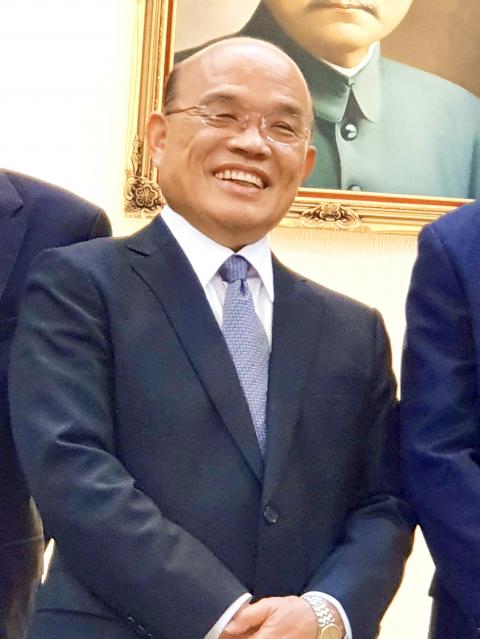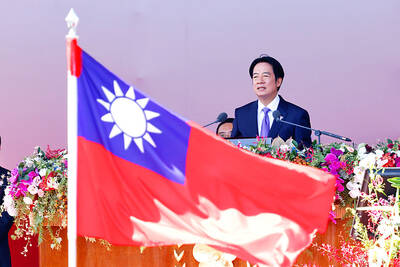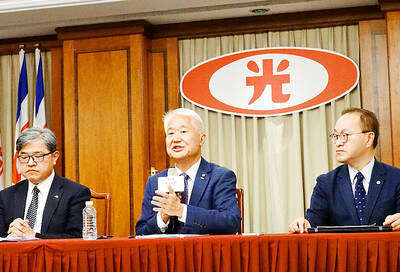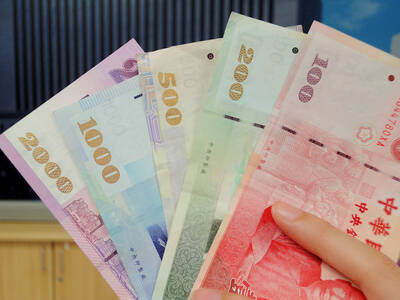Premier Su Tseng-chang (蘇貞昌) yesterday approved three plans proposed by the Ministry of Economic Affairs aimed at attracting an estimated NT$1.175 trillion (US$37.7 billion) of investment and 104,000 job opportunities over three years.
To encourage overseas Taiwanese to invest in Taiwan the government implemented the Action Plan for Welcoming Overseas Taiwanese Businesses to Return to Invest in Taiwan, which was funded by the National Development Fund.
However, due to the popularity of the scheme, the NT$20 billion allocated to the action plan has already been exhausted.

Photo: Li Hsin-fang, Taipei Times
As a result, a second edition of the plan, or Action Plan for Welcoming Overseas Taiwanese Businesses to Return to Invest in Taiwan 2.0, one of the three plans approved, was drafted.
The new plan promises an additional NT$500 billion in subsidies to overseas businesses returning to invest in Taiwan.
Under the new plan, the government is to subsidize 0.5 percent of the processing fees for businesses borrowing less than NT$2 billion, 0.3 percent for businesses borrowing NT$2 billion to NT$10 billion, and 0.1 percent for businesses borrowing more than NT$10 billion.
The loans must be repaid in five years, down from 10 years under the original plan.
The subsidies are to become available after the regulations have been confirmed, Deputy Minister of Economic Affairs Wang Mei-hua (王美花) said.
Meanwhile, the other two plans approved seek to extend the benefits to large businesses that have remained in Taiwan, as well as small and medium-sized enterprises.
Subsidies for the former group would be given according to the same rules that apply to overseas businesses returning to invest in Taiwan, while the latter would get a 1.5 percent subsidy.
The two groups are to be offered NT$80 billion and NT$20 billion in subsidies respectively.
The two plans are to take effect on July 1, Wang said.
The three plans would benefit not only businesses returning from abroad to invest in Taiwan, but also large enterprises that have never invested in China and small and medium-sized enterprises, Su said at a Cabinet meeting.
In addition to the subsidies, all three plans also have dedicated points of contact to help businesses secure land, water and electricity, and handle taxes, he said.
The government wants to show the corporate world and the public that it is determined to boost the economy, Su said.
It wants to demonstrate its effectiveness in reviewing applications, its flexibility in implementing plans and that it can “keep up with trends” and make adjustments as needed, he said.
The Cabinet on May 31 raised the foreign worker quota from 10 percent to 15 percent for multiple businesses, including Accton Technology Corp (智邦科技), the first company to be approved under the original action plan.
Additional reporting by CNA

People can preregister to receive their NT$10,000 (US$325) cash distributed from the central government on Nov. 5 after President William Lai (賴清德) yesterday signed the Special Budget for Strengthening Economic, Social and National Security Resilience, the Executive Yuan told a news conference last night. The special budget, passed by the Legislative Yuan on Friday last week with a cash handout budget of NT$236 billion, was officially submitted to the Executive Yuan and the Presidential Office yesterday afternoon. People can register through the official Web site at https://10000.gov.tw to have the funds deposited into their bank accounts, withdraw the funds at automated teller

PEACE AND STABILITY: Maintaining the cross-strait ‘status quo’ has long been the government’s position, the Ministry of Foreign Affairs said Taiwan is committed to maintaining the cross-strait “status quo” and seeks no escalation of tensions, the Ministry of Foreign Affairs (MOFA) said yesterday, rebutting a Time magazine opinion piece that described President William Lai (賴清德) as a “reckless leader.” The article, titled “The US Must Beware of Taiwan’s Reckless Leader,” was written by Lyle Goldstein, director of the Asia Program at the Washington-based Defense Priorities think tank. Goldstein wrote that Taiwan is “the world’s most dangerous flashpoint” amid ongoing conflicts in the Middle East and Russia’s invasion of Ukraine. He said that the situation in the Taiwan Strait has become less stable

CONCESSION: A Shin Kong official said that the firm was ‘willing to contribute’ to the nation, as the move would enable Nvidia Crop to build its headquarters in Taiwan Shin Kong Life Insurance Co (新光人壽) yesterday said it would relinquish land-use rights, or known as surface rights, for two plots in Taipei’s Beitou District (北投), paving the way for Nvidia Corp to expand its office footprint in Taiwan. The insurer said it made the decision “in the interest of the nation’s greater good” and would not seek compensation from taxpayers for potential future losses, calling the move a gesture to resolve a months-long impasse among the insurer, the Taipei City Government and the US chip giant. “The decision was made on the condition that the Taipei City Government reimburses the related

FRESH LOOK: A committee would gather expert and public input on the themes and visual motifs that would appear on the notes, the central bank governor said The central bank has launched a comprehensive redesign of New Taiwan dollar banknotes to enhance anti-counterfeiting measures, improve accessibility and align the bills with global sustainability standards, Governor Yang Chin-long (楊金龍) told a meeting of the legislature’s Finance Committee yesterday. The overhaul would affect all five denominations — NT$100, NT$200, NT$500, NT$1,000 and NT$2,000 notes — but not coins, Yang said. It would be the first major update to the banknotes in 24 years, as the current series, introduced in 2001, has remained in circulation amid rapid advances in printing technology and security standards. “Updating the notes is essential to safeguard the integrity